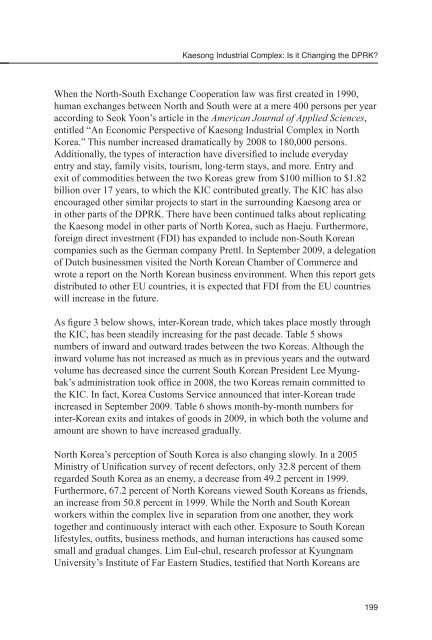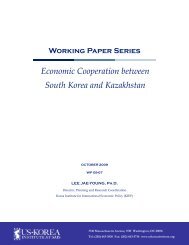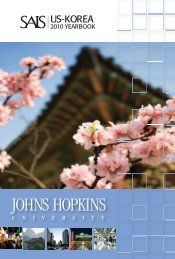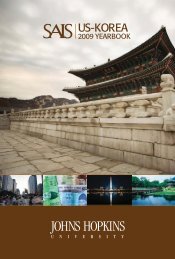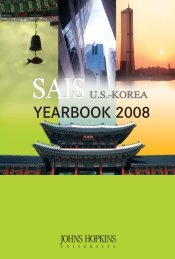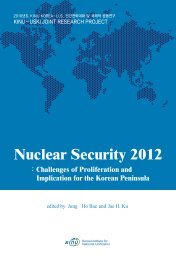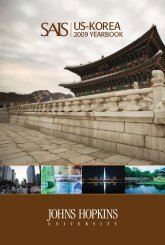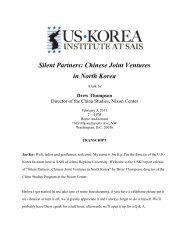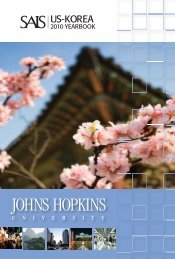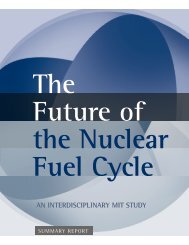Kaesong Industrial Complex - US-Korea Institute at SAIS
Kaesong Industrial Complex - US-Korea Institute at SAIS
Kaesong Industrial Complex - US-Korea Institute at SAIS
You also want an ePaper? Increase the reach of your titles
YUMPU automatically turns print PDFs into web optimized ePapers that Google loves.
<strong>Kaesong</strong> <strong>Industrial</strong> <strong>Complex</strong>: Is it Changing the DPRK?When the North-South Exchange Cooper<strong>at</strong>ion law was first cre<strong>at</strong>ed in 1990,human exchanges between North and South were <strong>at</strong> a mere 400 persons per yearaccording to Seok Yoon’s article in the American Journal of Applied Sciences,entitled “An Economic Perspective of <strong>Kaesong</strong> <strong>Industrial</strong> <strong>Complex</strong> in North<strong>Korea</strong>.” This number increased dram<strong>at</strong>ically by 2008 to 180,000 persons.Additionally, the types of interaction have diversified to include everydayentry and stay, family visits, tourism, long-term stays, and more. Entry andexit of commodities between the two <strong>Korea</strong>s grew from $100 million to $1.82billion over 17 years, to which the KIC contributed gre<strong>at</strong>ly. The KIC has alsoencouraged other similar projects to start in the surrounding <strong>Kaesong</strong> area orin other parts of the DPRK. There have been continued talks about replic<strong>at</strong>ingthe <strong>Kaesong</strong> model in other parts of North <strong>Korea</strong>, such as Haeju. Furthermore,foreign direct investment (FDI) has expanded to include non-South <strong>Korea</strong>ncompanies such as the German company Prettl. In September 2009, a deleg<strong>at</strong>ionof Dutch businessmen visited the North <strong>Korea</strong>n Chamber of Commerce andwrote a report on the North <strong>Korea</strong>n business environment. When this report getsdistributed to other EU countries, it is expected th<strong>at</strong> FDI from the EU countrieswill increase in the future.As figure 3 below shows, inter-<strong>Korea</strong>n trade, which takes place mostly throughthe KIC, has been steadily increasing for the past decade. Table 5 showsnumbers of inward and outward trades between the two <strong>Korea</strong>s. Although theinward volume has not increased as much as in previous years and the outwardvolume has decreased since the current South <strong>Korea</strong>n President Lee Myungbak’sadministr<strong>at</strong>ion took office in 2008, the two <strong>Korea</strong>s remain committed tothe KIC. In fact, <strong>Korea</strong> Customs Service announced th<strong>at</strong> inter-<strong>Korea</strong>n tradeincreased in September 2009. Table 6 shows month-by-month numbers forinter-<strong>Korea</strong>n exits and intakes of goods in 2009, in which both the volume andamount are shown to have increased gradually.North <strong>Korea</strong>’s perception of South <strong>Korea</strong> is also changing slowly. In a 2005Ministry of Unific<strong>at</strong>ion survey of recent defectors, only 32.8 percent of themregarded South <strong>Korea</strong> as an enemy, a decrease from 49.2 percent in 1999.Furthermore, 67.2 percent of North <strong>Korea</strong>ns viewed South <strong>Korea</strong>ns as friends,an increase from 50.8 percent in 1999. While the North and South <strong>Korea</strong>nworkers within the complex live in separ<strong>at</strong>ion from one another, they worktogether and continuously interact with each other. Exposure to South <strong>Korea</strong>nlifestyles, outfits, business methods, and human interactions has caused somesmall and gradual changes. Lim Eul-chul, research professor <strong>at</strong> KyungnamUniversity’s <strong>Institute</strong> of Far Eastern Studies, testified th<strong>at</strong> North <strong>Korea</strong>ns are199


